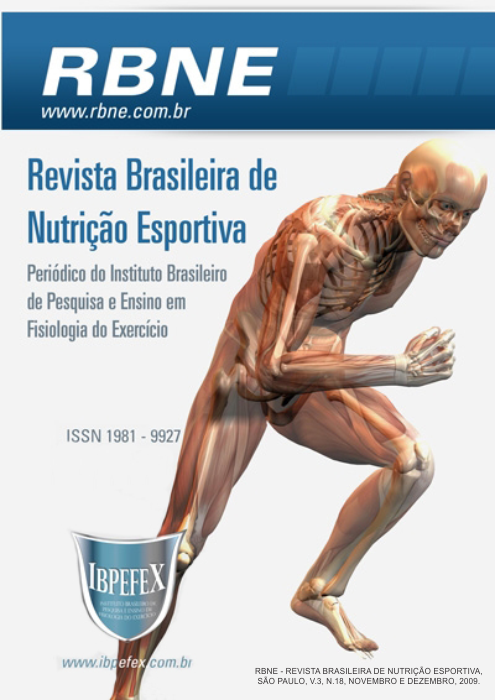Comparative study of the glycemic behavior on aerobic and resistance exercise with physically active individuals and daily conditions
Abstract
Modern life has brought many benefits to society, but also some problems arising from this evolution, which led to the increase of metabolic syndrome in a large population. The intention is to analyze the behavior of blood glucose in two types of exercises, the aerobic and the resistance in the normal conditions of the routine, 10 male students, adapted to exercise in a gym in Cuiabá city. They made twenty minutes of aerobic exercised in a treadmill, with 70 to 80% of maximum cardiac frequency intensity, and in the resistant exercise they made the leg press 45° machine and the barbell bench press, with 70 to 80% of 1RM intensity, previously determined. The blood samples for blood glucose were made in aerobic exercise on this way: on the rest and each five minutes of the test, until complete the twenty minutes. On the other hand in the assisted exercise the collect start on the rest, on the fifth and tenth repetition of each exercise done. The tests showed a significant relationship (p<0.036) for the aerobic exercise and (p<0.008) for the resistance exercise. Concluded that the blood glucose, in general, behaves differently. The blood glucose level was reduced to less than the beginning on the aerobic exercise, the opposite can be observed, the finals glycemic levels were higher than the baseline, thus the variation of blood glucose will depend on the exercise performed and if there is food or not.
References
- De-Oliveira, J.C.; Baldissera, V.; Simões, H.G.; Aguiar, A.P.; Azevedo, P.H.S.M.; Poian, P.A.F.O.; Perez, S.E.A. Identificação do limiar de lactato e limiar glicêmico em exercícios resistidos, Revista Brasileira de Medicina do Esporte. Vol. 12. Num. 6. Nov/dez 2006. p. 333-338.
- Duarte, J.M.P.; Rissato, G.M.; Carrara, V.K.P. Comparação entre limiar glicêmico, limiar anaeróbico individual estimado e velocidade crítica em sujeitos não atletas. Anuário da Produção de Iniciação Científica Discente. Vol. 11. Num. 12. 2008. p. 129-138.
- Febbraio, M.A.; Hiscock. N.; Sacchetti. M.; Fischer, C.P.; Pedersen, B.K. Interleukin-6 is a novel factor mediating glucose homeostasis during skeletal muscle contraction. Diabetes, Journal of the American Diabetes Association. Vol. 53. 2004. p. 1643-1648.
- Guyton, A.C. Tratado de fisiologia médica. 11ª edição. Rio de Janeiro. Guanabara Koogan. 2006.
- Lehman, M.; Foster, C.; Keul, J. Overtraining in endurance athletes: a brief review. Medicine Science Sports Exercise. Vol. 25. Num.7. 1993. p. 854-862.
- Lima-Silva, A.E.; Fernandes, T.C.; De-Oliveira, F.R.; Nakamura, F.Y.; Gevaerd, M.S. Metabolismo do glicogênio muscular durante o exercício físico: mecanismo de regulação. Revista de Nutrição, Campinas. Vol. 4. 2007. p. 417- 429.
- Mcardle, W.D.; Katch, F.I.; Katch, V.L. Fisiologia do exercício: energia, nutrição e desempenho humano. Rio de Janeiro. Guanabara. 2003.
- Nelson, D.L; Cox, M.M. "Lehninger principles of biochemistry", 4ª edição. W.H.Freeman. 2004.
- Pedersen, B.K.; Steensberg, A.; Fischer, C.; Keller. C.; Keller, P.; Plomgaard, P.; Pedersen, E.K.; Febraio, M. The metabolic role of IL-6 produce during exercise: is IL-6 an exercise factor? Proceedings of the nutrition society, Vol. 63, 2004. p. 263-267.
- Porpino, S.K.P.; Agnoleti, A.B.; Silva, A.S. Diferença no comportamento glicêmico em resposta a exercício de corrida e de musculação. Anais, X encontro de iniciação a docência. Paraíba, 2007.
- Prentice, A.M.; Jebb, S.A. Obesity in Britain: gluttony or sloth? Britsh Medical Journal. Vol. 311. 1995. p. 437-439.
- Rose, A.J.; Richter, E.A. Skeletal muscle glucose uptake during exercise: how is it regulated? Vol. 20. 2005. p. 260-270.
- Silva, L.G.M.; Pacheco, M.E.; Campbell, C.S.G.; Baldissera, V.; Simãoes, H. G. Comparação entre protocolos diretos e indiretos de avaliação da aptidão aeróbia em indivíduos fisicamente ativos. Revista Brasileira de Medicina do Esporte. Vol. 11. Num. 4. 2005. p. 219-223.
- Silveira Neto, E. Atividade física para diabéticos. Sprint, Rio de Janeiro, 2000.
- Simões, H.G.; Campebel, C.S.G.; Kokubun, E.; Denadai, B.S.; Baldissera, V. Blood glucose responses in humans mirror lactate responses for individual anaerobic threshold and for lactate minimum in track tests. European Journal of Applied Physiology and Occupational Physiology. Vol.80. Num. 1. 1999. p. 34-40.
- Teeple, E.; Shalvoi, R.M.; Feller, E. R. Overtraining in young athletes. Medicine Health Rhode Island. Vol. 89. Num. 7. 2006. p. 236-238.
- Winder, W.W. Control of hepatic glucose production during exercise. Medicine Science Sports Exercise. Vol. 17. Num. 1. 1985. p. 2-5.
Authors who publish in this journal agree to the following terms:
- Authors retain the copyright and grant the journal the right of first publication, with work simultaneously licensed under the Creative Commons Attribution License BY-NC which allows the sharing of the work with acknowledgment of the authorship of the work and initial publication in this journal.
- Authors are authorized to enter into additional contracts separately for non-exclusive distribution of the version of the work published in this journal (eg, publishing in institutional repository or book chapter), with acknowledgment of authorship and initial publication in this journal.
- Authors are allowed and encouraged to post and distribute their work online (eg, in institutional repositories or on their personal page) at any point before or during the editorial process, as this can bring about productive change as well as increase impact and impact. citation of published work (See The Effect of Free Access).






